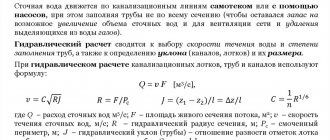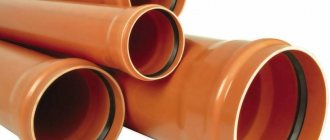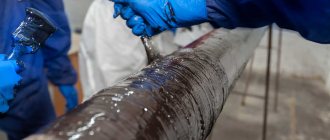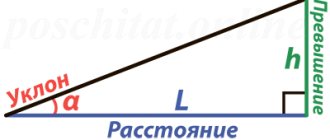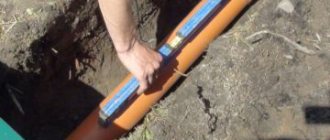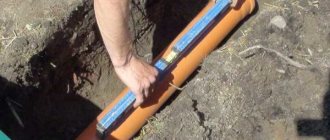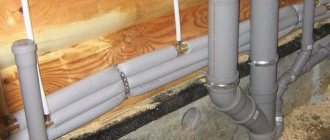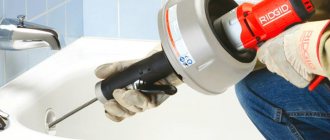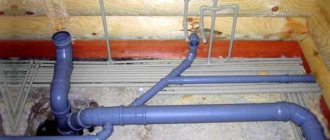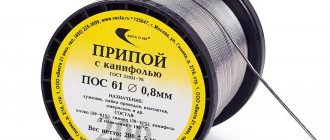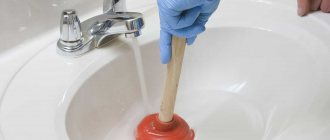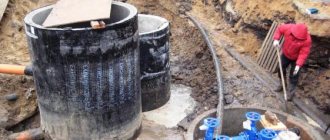There is sewerage in all houses and apartments. Its operation requires compliance with a number of rules. If they are neglected, fat begins to accumulate in the system pipeline, which causes blockages. There are several ways to solve this problem. They differ in their effectiveness and the means used. For example, property owners often use a grease remover on their drains.
Popular chemicals
How to flush sewer pipes? The “Mole” remedy has been known to many families for several generations, as it has been used for quite a long time. With its help you can remove plugs from hair and threads, fatty organic compounds. Used for all types of sewer pipes. It is also used to prevent blockages.
Liquid product – “Mole”
How to clean sewer pipes in case of serious blockage? In this case, it is worth using Tiret: it is safe for metal and other types of sewer pipes. The brand's line includes products to prevent congestion, which allows you to use a strong and expensive base gel much less often. Country of origin: Poland.
Types of gel:
- Professional.
- Turbo.
- Preventive
The types differ according to the percentage of active substances.
Mister Muscle cleaner
Flushing sewer pipes is possible using products from the Mister Muscle brand. This product is gentle on sewer pipes and has many positive reviews from consumers. Foam and gel are available for sale. The most effective solution in case of blockage is foam. The product dissolves organic deposits, eliminates unpleasant odors, and destroys bacteria.
You can get rid of clogs in sewer pipes using a chemical product produced in Israel, Baghi Pothan.
Causes of blockages removed by the product:
- Hair.
- Fat.
- Paper.
- Limescale.
Designed for cleaning metal and plastic pipes. It is recommended to avoid contact with the surfaces of bathtubs, sinks, washbasins, not to mention the skin of humans and animals.
When using this product, you should be very careful, since the reaction occurs immediately after adding water. Before pouring in the chemical, it is necessary to remove 5 cm of water standing in the drain. It is recommended to turn on the hood and open the windows during the cleaning process.
"Bagi Pothan" - a means of combating blockages
The Floop product is available in granules. Types of product release:
- For filling with hot water.
- For filling with cold water.
Floop granules, designed for pouring hot water, act much faster. The powder is poured into the drain hole, half a glass of hot water (70-80 degrees) is poured, left for some time (according to the inscription on the package) and washed with large quantities of water. Work is carried out with gloves, carefully avoiding contact with eyes and skin.
Granular product
By using chemicals, you not only solve the problem of blockage, but also disinfect the sewer pipeline, getting rid of bacteria and unpleasant odors. For long-term operation of the sewage system without blockages, it is necessary to carry out preventive cleaning using chemicals intended for this purpose.
Prevention of greasy sewer contamination
With the help of prevention, it is impossible to completely stop pollution of wastewater, especially oil and fat, but it is possible to slow down the formation of traffic jams. Thanks to these measures, the need for major sewer cleanings will arise much less frequently.
- Do not flush copious fatty residues after cooking down the sink or toilet - scoop them up with a spatula, put them in a garbage bag, tie it up and throw it in the trash can.
- If you are washing greasy dishes, immediately after washing, pour a special pipe cleaning gel into the sink drain, leave for the time specified in the instructions, and rinse with plenty of water.
- Remove grease from dishes by hand before placing them in the dishwasher.
- Do not throw personal hygiene items, rags, diapers, cat litter, cotton swabs or pads down the sink or toilet.
- Use protective screens for sink and kitchen sink drains.
- Install special filters for pre-purification of cold and hot water.
You can get more accurate and detailed recommendations on the maintenance of your sewer networks from Dez Group specialists when ordering or providing sewer cleaning services.
Cleaning at home
If the blockage in the pipes is not too global, then you can deal with it using home methods. Among them:
- Cleaning the system with a plunger.
- Use of household chemicals.
- Cleaning with a plumbing cable.
Using a plunger
Using a plunger - the simplest plumbing tool - cleaning pipes is easy and safe. The work goes like this:
- If there is an overflow hole in the sink, it must be tightly plugged with a stopper.
- A small amount of water is collected in the sink.
- Now you need to install the plunger so that its rubber part completely blocks the drain hole.
- Having finished swinging, you need to sharply pull the plunger out of the water.
- If after this the collected water easily goes down the drain, it means that the cleaning of the sewer pipes was successful. Otherwise, you should repeat the operation 1-2 more times.
Chemical cleaning methods
If the water begins to drain worse from the kitchen sink, then it is most likely necessary to clean the sewer pipes of grease. This can be done using regular baking soda or special household chemicals. Cleaning the sewer from grease using soda is carried out as follows:
- Carefully pour a glass of soda into the hole in the sink, then pour three glasses of boiling water there. After 2-3 hours, rinse the pipes with water. The resulting alkaline solution perfectly cleans the pipes of grease.
- Instead of one soda, you can take a mixture of equal parts (half a glass) of soda and salt. After pouring this mixture into the drain, pour boiling water there.
- Having poured soda into the drain, you can pour it not with boiling water, but with ordinary food vinegar. The resulting neutralization reaction between acid and alkali will lead to the dissolution of fatty deposits.
If it is not possible to cope with fat deposits in pipes with the help of soda, you can resort to the use of more effective, but, unfortunately, more aggressive drugs. You can buy a product for the sewer system in almost any store that sells household goods.
To restore the functioning of the drain in the kitchen sink, chemical cleaning of the sewage system using alkali-based preparations is used. Such products can be liquid, made in the form of a gel or granular powder. The work comes like this:
- To clean the drainage system, you need to pour (fill in if using a dry product) a sewer pipe cleaner into the drain of the sink or washbasin.
- If a dry product is used, then after it you need to pour a little water into the hole.
- Allow the product to work in the pipes by stopping using the sink for a while. The exposure time is indicated in the instructions; it can range from several minutes to several hours. Some products recommend leaving it on overnight.
If you need to clean a bathroom or sink drain, you should use an acid-based drain cleaner. It is precisely such products that dissolve hair well, the accumulation of which, most often, is the cause of clogging of pipes in this place.
Wire cleaning
If you don’t want to use aggressive chemicals, and manipulations with a plunger do not bring results, then when solving the problem of how to clean sewer pipes at home, there is only one way out - using a plumbing cable.
This name goes to a special device, which is a long (5-10 meters) steel wire, on one side of which a handle is installed on the wire. For greater efficiency, it is recommended to use special nozzles that are attached to the end of the cable that is inserted into the pipe.
When using a cable, cleaning the sewer system in a private house or apartment proceeds as follows:
- The entrance to the sewer pipe opens. This could be an inspection hatch or a pipe under the sink from which the siphon should be removed.
- It is more convenient to work with the cable together. One of the workers will guide the cable, the second will rotate the handle.
- The cable should be moved along the pipe, pulling it out from time to time to clean off any dirt adhering to it.
Pipe cleaning equipment such as a cable allows you not only to break through the debris plug, but also to clean the pipes from internal deposits. However, it is quite labor-intensive and messy. After the integrity of the pipe has been restored, you need to rinse the system thoroughly with hot water.
How to understand that a greasy plug is beginning to form in the pipes
The main signs of blockage:
- water drains slowly in the bathtub or sink;
- there is a stench coming from the drain hole.
To solve a problem, you need to identify the cause of its occurrence. Most clogs appear due to the accumulation of grease particles that remain in the pipeline after washing dishes. The sticky substance collects on the walls of the pipes. Gradually, hair, pieces of tissue, remnants of nutritious foods, etc. stick to it. As a result, a plug forms in the pipe, which prevents the free passage of liquid waste through the pipeline.
A favorable factor for accumulation is cold running water.
Professional help for complex blockages
In most cases, the methods listed above are effective, but this is not always the case. If you couldn’t solve the problem on your own, it’s time to invite specialists. To begin with, they will conduct a video diagnosis of the condition of the sewer system, at the same time finding out not only the location and nature of the blockage, but also the general condition of the pipeline. Then one of the following methods will be applied:
- hydrodynamic method, in which a jet of water under high pressure is supplied to the sewer;
- thermochemical cleaning using special products heated to high temperatures;
- pneumatic-hydropulse sewerage cleaning by transmitting high-power second pulses through the system.
Thanks to modern equipment, teams can deal with the blockage in the shortest possible time.
You should not think that such a nuisance as a clogged sewer is possible only where sloppy people live. In fact, operational blockages are also common, that is, those formed as a result of normal sewer use. The effluent contains grease, debris, sand, and hair; they can greatly narrow the lumen of the pipe and reduce its throughput. To correct the situation, pipe cleaning is necessary. For small blockages, you can deal with the problem yourself, but in some cases it is more profitable to turn to the services of professionals.
A clogged drain is an unpleasant occurrence. The water stops draining and a disgusting smell appears in the rooms. Naturally, such a situation cannot be considered normal, and urgent measures must be taken to eliminate the accident.
It must be said that cleaning sewer pipes can be entrusted to professionals. In this case, a special station that creates pressure and special cleaning methods will be used. But if the blockage is small, then you can easily do it yourself. Let's look at what methods can be used for cleaning.
Why does grease settle on pipes?
Every day, when washing dishes and pouring leftover food into the toilet, a large volume of water containing fat impurities passes through the pipes. It is a mistake to think that they are completely dissolved by dishwashing detergents.
A large amount of fat remains and settles in the water supply and sewerage systems, turning into a sticky film that lines the inside of the pipes layer by layer. Over time, threads, hair, and other small debris stick to it and a dense plug is formed, through which complete drainage cannot be performed. The appearance of an unpleasant odor is a sure sign of a blockage.
This problem often appears if cast iron sewer pipes are installed in a house or apartment. The rough structure of the metal promotes the adhesion of fatty deposits to it. If we talk about modern polypropylene and PVC pipes, blockages in them are formed due to the deformation of the material during its long-term operation.
Favorable conditions for fat accumulation are:
- washing dishes in cold water;
- draining cooled soup or broth down the drain;
- washing pans and pots without using special products;
- improperly installed sewerage / plumbing.
To avoid fat accumulation, preventative measures must be taken periodically. If a blockage does occur, you can eliminate it yourself using simple methods and available means.
Using household chemicals
Effective cleaning of sewer pipes is also successfully performed using special gels or powders. You just need to carefully read the instructions and strictly follow the manufacturer's instructions. Usually the procedure is to pour the powder or gel into the drain hole and wait a while.
If, after the time specified by the manufacturer, the accumulated water has not begun to subside, you should use a plunger. A few vigorous strokes will help remove a clog that has already been exposed to chemicals.
If such means for quickly cleaning sewer pipes are not available for some reason, you can use substances that can be easily found in any kitchen. The simplest option is to pour a couple of liters of boiling water into the drain hole. Sometimes this is quite enough to dissolve the fat plug. And in general, to prevent operational blockages, it is recommended to pour boiling water down the drain every time after washing very greasy dishes. Grease will be washed off the walls of the sewer pipe more efficiently and the likelihood of blockage will be significantly reduced.
Regular baking soda creates an alkaline environment in pipes, dissolves blockages and disinfects the pipeline from the inside. It is also used in combination with vinegar, salt and other substances
There are several recipes on how to clean a clogged sewer pipe with soda. Regular baking soda is effectively used in combination with vinegar, salt and other substances.
Soda and boiling water
Procedure:
- First you need to pour about a liter of boiling water down the drain.
- After a quarter of an hour, try to clear the drain with a plunger.
- Then add a glass of baking soda and pour in another three glasses of boiling water.
If necessary, this procedure can be repeated several times. An alkaline environment is formed in the sewer system, which will not only dissolve the blockage, but also disinfect the walls of the sewer pipes.
Soda and salt
Procedure:
- Baking soda and table salt are mixed in equal proportions, for example, half a glass.
- The mixture is poured into the drain hole.
- Pour in about 1 liter of boiling water.
After this, you need to let the mixture act for about 8-12 hours. During this period, it is not recommended to use the sewer.
Soda and vinegar
Procedure:
- First, pour half a glass of soda into the drain hole.
- Then pour in approximately the same amount of vinegar.
- The drain hole is closed with a plug.
- After about two hours, about a liter of boiling water is poured into the drain.
Please note that when alkali (soda) and acid (vinegar) combine, a large amount of foam is formed and carbon dioxide is released
Cleaning a greasy kitchen ceiling
The ceiling, especially above the stove, also gradually accumulates grease and dirt. Cleaning of products depends on the type of materials used or surface treatment. Painted or plastered ceilings are cleaned using dry methods using a soft brush or a vacuum cleaner with a special pad.
Heavy dirt and grease stains on a painted ceiling are removed with a solution of water and vitriol, which is applied only to contaminated areas. Plaster cannot be washed with water! If stains cannot be cleaned using the dry method, renew the layer of plaster.
The wooden ceiling is washed with a damp and well-wrung cloth using a weak soap solution or plain warm water. After treatment, the wood is wiped with a soft, dry cloth.
Ceilings finished with plastic can be washed with any means that do not contain solvents, chlorine or abrasives. Detergents for windows, glass and mirrors are well suited. If the plastic has turned yellow, soap solution, soda, hydrogen peroxide, ammonia or acetone will help restore the whiteness.
Ceiling tiles are washed depending on the type of materials. Laminated boards can be cleaned with a mild soap solution and a soft cloth, non-laminated boards can only be cleaned using the dry method using a brush, cloth or vacuum cleaner with a special attachment.
Mirror and glass tiles are washed with special products for cleaning mirrors and glass. Do not use large amounts of water on ceiling tiles!
To wash a suspended ceiling, use a regular soap solution with warm water or special alcohol-containing polishes with an antistatic effect, which return shine and gloss to the surface, do not leave soap stains, and do not deform or damage the material.
For a glossy stretch ceiling, you can also use classic cleaning compounds for mirrors and glass. But such products are not suitable for a matte ceiling! How to wash a suspended ceiling in the kitchen without streaks, read here.
When washing any type of ceiling, do not use abrasive detergents and bleaches containing chlorine, soda and hard powders, acids and alkaline solutions, hard sponges, washcloths and brushes!
Do I need to clean the drain from grease?
Regardless of the material from which the sewer is made, grease quickly adheres to the inner walls in a continuous sticky layer.
Small household and food waste, which also falls into the sewer, sticks to this film, forming quite strong blockages. In cast iron pipes, the hole can be clogged by fallen scale, which can only be removed mechanically.
Fat is a favorable environment for the rapid development of various bacteria, which globally disrupt the sanitary condition of the kitchen and smell very bad.
If an unpleasant, stagnant odor appears near the washbasin in the kitchen, it is necessary to clean and sanitize the sewerage system.
How does fat cause clogs?
Both animal and vegetable fats do not dissolve in water. They are destroyed by alkalis, so washing dishes using household chemicals is a good preventative against blockages.
It’s just that in hot water fats turn into an emulsion, and in cold water they solidify, forming a solid layer. And since the temperature in the sewer system is generally kept low, the deposits become thicker over time and reduce the clearance in the pipes. In addition, the remains of other food stick to the fat: cereals, pasta, ground coffee.
The main causes of fatty plugs are the following actions of residents:
- Draining oils into the sink. In particular, from a frying pan after frying cutlets, from a tin can after eating sprats.
- Draining expired dairy products into the sink: milk, kefir, sour cream, cream.
- Removing the top foam when boiling meat. It also contains fat.
- Washing greasy dishes without using detergent.
The risk of blockages increases sharply if the pipes are thin or have sharp bends. Residents of old apartment buildings often suffer from this problem.
Mechanical methods for cleaning sewer pipes
This method of cleaning pipes from fatty deposits is no less effective. If you do not know how to use this method, then you can always use the services of a plumber.
When using a mechanical cleaning method, a plumbing cable is most often used, which looks like a long piece of wire. At its end there is a handle that is subject to rotation. The cable is very ductile and flexible and has high strength. At the opposite end of the wire there is a special tip, thanks to which the blockage in the pipe is removed.
Before using the method, you need to prepare a special container for storing the clog. Start by removing any water that has accumulated in the drain. Next, fill in clean water and determine how much of it is consumed. The cable must be placed in the sewer pipe and begin to move in a circle, turning it inside the pipe. After completing the procedure, the tip is treated with oil intended for lubricating machine parts.
